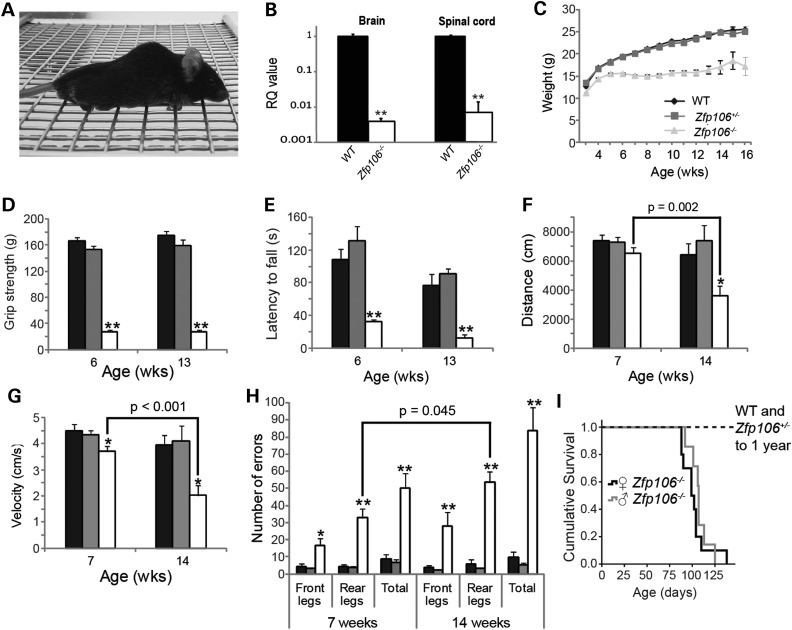Figure 1.
Behavioural analyses of Zfp106−/− mice reveal severe motor abnormalities. Black bars: Zfp106−/−, grey bars: Zfp106+/−, white bars: Zfp106−/−. (A) Photograph of mutant Zfp106−/− mouse at 15-weeks of age displaying pronounced kyphosis and unable to coordinate hind limbs on wire grate. (B) qPCR analysis of Zfp106 expression levels in brain and spinal cord of 6-week-old male WT and Zfp106−/− littermates (n = 3 per genotype); expression in Zfp106−/− mice is normalized to Zfp106 expression in respective WT tissues, taken as a value of 1 (Log scale). (C) Female weights recorded weekly from ages 3 to 15 weeks; at least five mice were assessed per genotype per time point. Weight is diminished in Zfp106−/− female mice from 3-weeks of age (P = 0.04) and continues to significantly decrease, compared with WT and Zfp106+/− animals, to 15-weeks of age (P < 0.001). (D) Female grip strength and (E) accelerated Rotarod performance are reduced in Zfp106−/− mice at 6- and 13-weeks of age compared with WT and Zfp106+/− littermates (n≥ 6 per genotype). (F and G) Open field assessment of (F) distance moved, and (G) velocity for female mice at 7- and 14-weeks of age (see ‘Materials and Methods’). A reduction in distance moved (F), and velocity (G), was seen in 14-week-old female Zfp106−/− mice when compared with 7-week female Zfp106−/− mice; P values are indicated (n ≥ 5 per genotype and time point) and 14-week old WT littermates. (H) Female mice assessed for defects in coordination of front and rear legs at 7- and 14-weeks of age using the Locotronic® system (see ‘Materials and Methods’). Zfp106−/− mice made significantly more front and rear leg placement errors compared with WT littermates. Rear leg errors also significantly increased for 14-week-old Zfp106−/− mice compared with 7-week-old Zfp106−/− mice (n ≥ 5 per time point and genotype; P value indicated). Numbers and percentages shown represent the mean ± SEM. *P < 0.05; **P < 0.001. (I) Survival of male and female Zfp106−/− mice as determined by their humane endpoint (see ‘Materials and Methods’).

